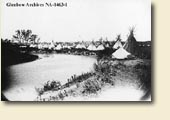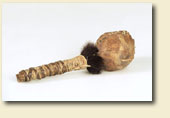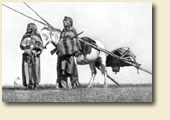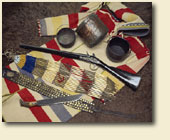Instructional Units
 These
instructional units were created to compliment and extend the Niitsitapiisini
Virtual Exhibit and web activities. Classroom teachers, the Glenbow
Museum and members of the Canadian and American Blackfoot Nations
worked together in a collaborative effort to produce the materials
that are
found within these units and resource documents.
These
instructional units were created to compliment and extend the Niitsitapiisini
Virtual Exhibit and web activities. Classroom teachers, the Glenbow
Museum and members of the Canadian and American Blackfoot Nations
worked together in a collaborative effort to produce the materials
that are
found within these units and resource documents.
The lessons include activites and assessment strategies to meet a variety of learner styles. Each unit also includes a resource document that provides cultural and historical resources to support the unit.
The instructional units match and extend the major areas of focus in the virtual exhibit:
Relationship with the Land
Relationship with the Buffalo
Relationship with Family
Relationship with Others
![]()
 Relationship
with the Land
Relationship
with the Land
An Amsskaapipikani – (South Piegan) Seasonal Round
 Target group: Grade 4 to 6
Target group: Grade 4 to 6
This instructional unit is designed to help students understand how
topographical features influenced the lifestyle and culture of the “Amsskaapipikani – South
Piegan” tribe through the exploration of the seasonal Round.
This unit contains historical and cultural resources to help students
recognize the concepts of time and the seasons in the historical perspective
of the “Amsskaapipikani – South Piegan” tribe. The
unit includes maps, archival images and a historically documented interview
with Jim Blood
Land Unit (pdf file 282 kb)
Land Resources (pdf file 955 kb)
Land Seasonal Round Resource (pdf file 884 kb)
 Relationship
with the Buffalo
Relationship
with the Buffalo
 The
Pisskun unit has been developed as a way for students and their teachers
to explore this particular aspect of Blackfoot life and culture. These
lessons focus primarily on Language Arts and Social Studies outcomes.
This unit also contains adapted materials to support a diverse learner
group. The unit includes archival images, and historical background
on Story Robes and the buffalo.
The
Pisskun unit has been developed as a way for students and their teachers
to explore this particular aspect of Blackfoot life and culture. These
lessons focus primarily on Language Arts and Social Studies outcomes.
This unit also contains adapted materials to support a diverse learner
group. The unit includes archival images, and historical background
on Story Robes and the buffalo.
Buffalo Unit (pdf file - 2.63 mb)
Buffalo Resources (pdf file - 879 kb)
Story Robe (pdf file - 879 kb)
 Relationship
with the Family
Relationship
with the Family
 In
this unit students will explore and discover how the Blackfoot people
of the Canadian and American prairies lived and thrived within their
environment. The lessons focus primarily on Language Arts and Social
Studies outcomes.
This unit also contains adapted materials to support a diverse learner
group. The unit includes archival images, and historical background
on Story Robes and the buffalo.
In
this unit students will explore and discover how the Blackfoot people
of the Canadian and American prairies lived and thrived within their
environment. The lessons focus primarily on Language Arts and Social
Studies outcomes.
This unit also contains adapted materials to support a diverse learner
group. The unit includes archival images, and historical background
on Story Robes and the buffalo.
Family Unit (pdf file 1.24 mb)
Family Resources (pdf file 1.00 mb)
 Relationships
with Other People
Relationships
with Other People
 Through
this unit, students will come to understand how, in living with other
people (both First Nations and others), the Blackfoot culture, territory
and way of life has been impacted, especially over the last two hundred
years.
Through
this unit, students will come to understand how, in living with other
people (both First Nations and others), the Blackfoot culture, territory
and way of life has been impacted, especially over the last two hundred
years.
Students will reflect and comment on the changes the Blackfoot people
have undergone and, at the grade six level, will be asked to compare
the Blackfoot experience to another indigenous culture, somewhere else
in Canada or the world. This unit also contains adapted materials to
support a diverse learner group. The Others resource document includes
archival images to support the unit. Teachers can also print off the
historical information from the Blackfoot Culture section of the toolkit.
Others Unit (pdf file 466 kb)
Others Resources (pdf file 995 kb)
About the images (in order of appearance):
Many Blackfoot tipis were
painted with special designs that came to people
in dreams. These designs helped the family have a good life.
Glenbow Archives NA-919-37
Blackfoot camps were composed of members of an extended family and
other people who may have joined the clan. The arrangement of the tipis
was not strictly defined in these camps, although all of them faced
east. This allowed the morning prayers to travel towards the rising
sun, helping it to come above the horizon for another day.
Glenbow
Archives NA-1463-1
Rattles were made from buffalo bulls' scrotums.
Collection of Glenbow Museum
The Blackfoot used a travois to move their belongings. This one is
pulled by a horse, but dogs were also used to pull smaller travois.
Photograph by Edward Curtis, Glenbow Archives NA-1700-156
Trade Goods
Collection of Glenbow Museum





